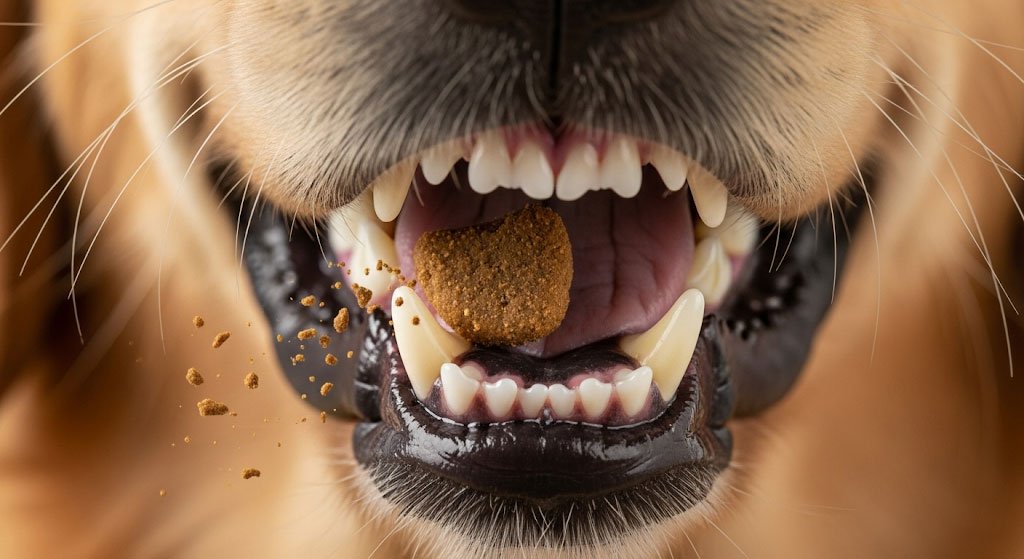Dry Dog Food Guide: Essential Pros, Cons & How to Choose the Healthiest Kibble for Your Dog

Introduction to Dry Dog Food
Dry dog food, commonly referred to as kibble, is a popular choice among dog owners due to its convenience, shelf stability, and cost-effectiveness. Unlike wet dog food, which can be cumbersome to store and serve, kibble is dry, making it easy to portion and feed. The production of kibble involves a process known as extrusion, where ingredients are mixed, cooked, and then shaped into the small, bite-sized pieces that dog owners are familiar with. This method not only makes kibble palatable for dogs but also helps in preserving the essential nutrients that contribute to a balanced diet.
The nutritional components included in kibble vary but generally consist of proteins, carbohydrates, fats, vitamins, and minerals. These ingredients are carefully selected to meet the dietary needs of dogs, providing them with energy and supporting their overall health. In recent years, advances in pet nutrition have led to the development of formulations that address specific health concerns, such as weight management, skin and coat health, and digestive support, making the healthiest dry dog food options more accessible to pet owners.
As dog owners consider their options, it is crucial to understand the implications of choosing kibble for dogs. While dry dog food offers several advantages, there are also drawbacks that merit consideration. Throughout this article, we will explore the inherent pros and cons of dry dog food, ultimately assisting prospective buyers in determining the best dry dog food for their canine companions. By recognizing both the benefits and limitations of kibble, dog owners can make informed decisions that align with their pet’s nutritional requirements and personal preferences.
Benefits of Dry Dog Food
When it comes to choosing kibble for dogs, dry dog food stands out for a variety of reasons. One of the primary benefits is the convenience it offers to pet owners. Unlike wet food, which requires refrigeration and can lead to mess during serving, dry dog food can be easily measured and stored without any special requirements. The manageable packaging allows for simple pouring into bowls, making mealtime preparation quick and hassle-free.
Moreover, dry dog food typically boasts a longer shelf life than other options. This long shelf life not only reduces the risk of spoilage but also helps owners to stock up in advance without the concern of food going bad. For those with busy lifestyles, this longevity is a huge advantage, enabling them to have a ready supply of food without frequent trips to the store.

Dental health is another significant aspect where dry dog food excels. The crunchy texture of dog kibble helps in reducing plaque buildup and promotes healthier gums. Regular chewing of dry food can aid in maintaining dental hygiene, which is crucial for preventing more serious dental problems in dogs as they age. This health benefit aligns with the broader goal of ensuring a long and healthy life for our canine companions.
Lastly, dry dog food is often more cost-effective compared to wet food alternatives. It can be produced at a lower cost, allowing pet owners to provide quality nutrition without straining their budgets. Consequently, the best dry dog food options on the market tend to balance affordability with the nutritional requirements of dogs, allowing owners to make informed choices for their pets’ diets.
Overall, the benefits of feeding dogs dry food encompass convenience, extended shelf life, oral health promotion, and affordability, making it a practical choice for many dog owners.
Nutritional Considerations
When contemplating the best dry dog food for your pet, understanding the nutritional composition of dog kibble is crucial. Kibble must contain a balanced mixture of proteins, fats, carbohydrates, vitamins, and minerals to support optimal canine health. A high-quality dry dog food should ideally have animal-based proteins as the primary ingredient, as these are critical for muscle development and overall vitality. Be keen to evaluate the meat content listed in the ingredients to ensure it meets your dog’s dietary needs.
The fats present in dry dog food are also essential, serving as vital sources of energy while supporting skin and coat health. Look for healthy fats such as omega-3 and omega-6 fatty acids, which can greatly contribute to your dog’s overall well-being. Carbohydrates should also be a part of a balanced diet, providing energy and aiding digestion. Whole grains like brown rice and oats, or vegetables like sweet potatoes, are better sources than fillers like corn or soy.
Additionally, vitamins and minerals play a pivotal role in maintaining a dog’s health. They support various bodily functions and are essential for growth and development. When selecting kibble, it’s necessary to consider dog food that provides a comprehensive range of these vital nutrients. Learning how to read ingredient labels becomes invaluable in this process. Prioritize brands that list specific meat sources, whole foods, and avoid those with vague terms like “meat by-products.”
By understanding the nutritional aspects of dog kibble and making informed choices, you can significantly influence your pet’s health. Investing time in selecting the healthiest dry dog food will ensure that you are providing a balanced diet that meets their needs throughout different life stages.
Potential Drawbacks of Dry Dog Food
While dry dog food, commonly referred to as kibble, is a popular choice among pet owners, it is essential to recognize its potential drawbacks. One significant concern is the quality of ingredients used in various dry dog food brands. Many manufacturers may utilize low-quality components, which can lack essential nutrients required for a dog’s optimal health. This can lead to deficiencies over time, especially if the kibble is the sole source of nutrition.
Another notable drawback involves allergens that can be present in kibble. Various grains, meat by-products, and artificial additives often found in these products may trigger allergic reactions in some dogs. Symptoms can range from skin irritations to gastrointestinal disturbances, creating discomfort for pets and challenges for their owners when selecting the healthiest dry dog food.
Additionally, kibble can pose a dehydration risk for dogs. Unlike wet food, which has a higher moisture content, kibble is relatively dry. If a dog does not drink enough water, this can lead to dehydration, which is particularly concerning for older dogs or those with specific health conditions. It is crucial for owners to ensure their dogs have constant access to fresh water, especially when feeding them dry food.
Finally, it is important to consider that dry dog food may not be suitable for all dogs. For pets with specific dietary restrictions, medical issues, or preferences for moist textures, kibble might not fulfill their nutritional needs. Furthermore, certain breeds can be more prone to dental issues, and while kibble is often touted for promoting dental health, it may not provide sufficient cleaning for every dog. Careful consideration and consultation with a veterinarian are advisable when choosing kibble for dogs.
Comparing Kibble with Wet Dog Food
When considering the dietary options for dogs, many pet owners often find themselves choosing between dry dog food, commonly known as kibble, and its wet counterpart. Each type has distinct advantages and disadvantages that can impact a dog’s health, palatability, and overall well-being.
One notable difference between dry dog food and wet dog food is moisture content. Kibble typically contains around 10% moisture, while wet dog food can range from 70% to 80% moisture. This higher moisture level can be particularly beneficial for dogs that may not drink enough water or need increased hydration, such as those with certain health conditions. However, the lower moisture content in kibble does provide an advantage in terms of dental health, as the crunchiness of kibble can help reduce tartar buildup on teeth.

Health benefits also differ between the two options. Dry dog food often includes preservatives and is less likely to spoil, making it a convenient and durable choice. Moreover, the best dry dog food formulations typically include essential nutrients, vitamins, and minerals that are important for maintaining canine health. On the contrary, wet dog food usually has a higher palatability due to its smell and texture, which can be an enticing option for picky eaters or dogs recovering from illness.
Cost is another consideration when choosing kibble for dogs. Generally, dry dog food is more cost-effective than wet dog food, allowing pet owners to feed their dogs a balanced diet without significantly straining their budgets. In terms of storage, kibble is easier to manage; it requires less refrigeration and has a longer shelf life. This can be a crucial factor for dog owners who prefer convenience and efficiency when it comes to pet care.
Both dry dog food and wet dog food have their pros and cons, and the choice ultimately depends on individual circumstances, preferences, and specific health needs of dogs. Assessing factors such as hydration, dental health, palatability, cost, and storage will lead to a more informed decision for pet owners.
Choosing the Right Kibble for Your Dog
Selecting the right dry dog food, commonly known as kibble, is crucial for ensuring your pet receives the necessary nutrients needed for their specific breed, size, and life stage. The healthiest dry dog food option will vary significantly between puppies, adult dogs, and seniors, largely due to their varying energy requirements and nutrient needs. Puppies require a higher caloric intake and specific vitamins and minerals to support their rapid growth, whereas older dogs may need formulas with lower calories and added supplements for joint health.
When choosing kibble for dogs, it’s essential to consider your dog’s weight and activity level. Active breeds may thrive on high-protein formulas that provide energy, while less active dogs benefit from lower-calorie diets to prevent obesity. Furthermore, weight management is vital; dog kibble should be evaluated based on its caloric content, portion sizes, and feeding guidelines. Consulting with a veterinarian can greatly assist in determining the best dry dog food for your dog, particularly if there are specific health concerns such as allergies, diabetes, or sensitivity to certain ingredients.
Transitioning your dog to a new kibble requires careful handling to mitigate gastrointestinal upset. It is advisable to conduct a gradual introduction over the course of 7 to 10 days, mixing a small amount of the new food with the existing diet and gradually increasing the proportion. This approach not only allows for a smoother switch but helps monitor your dog’s reaction to the new kibble. It’s essential to observe your dog for any signs of intolerance or allergies during this transition.
In essence, when choosing the right kibble for your dog, consider factors such as age, weight, activity level, specific health needs, and the transition process. The proper choice will lead to improved health and satisfaction for your canine companion.
Common Misconceptions About Kibble
Dry dog food, often referred to as kibble, has been a staple in canine nutrition for decades. Despite its popularity, numerous misconceptions abound concerning its safety, digestibility, and suitability for dogs with allergies. These myths can influence dog owners’ decisions, leading to unnecessary confusion and concern.
One prevalent myth is that dry dog food is inherently unsafe for canines. This misconception may stem from the fact that some kibble brands have been subject to recalls due to contamination. However, it is crucial to note that most kibbles are produced under strict safety regulations, and the best dry dog food brands invest significantly in quality control. Research suggests that when sourced from reputable manufacturers, dry dog food can be both safe and nutritious for dogs.
Another common belief is that kibble is difficult for dogs to digest. This notion often arises from observing dogs regurgitating their food. In reality, many dogs thrive on kibble as it is designed to meet their specific nutritional needs, including essential vitamins and minerals. The healthiest dry dog food options are formulated to be easily digestible, providing balanced nutrition that can support a dog’s overall health.
Concerns about allergies are also prevalent among dog owners. Some believe that dry food causes allergies or food sensitivities in dogs. While it is true that certain ingredients in kibble can trigger allergic reactions, this is not the case for every dog. It is significant to consider that some dogs may be allergic to specific proteins rather than the kibble itself. Choosing kibble for dogs with allergies requires careful selection of ingredients and consultation with a veterinarian. As understanding of canine nutrition evolves, dispelling these myths can promote informed decisions regarding dog kibble, ultimately benefiting both pets and their owners.
How to Properly Store and Serve Dry Dog Food
Proper storage and serving of dry dog food, commonly referred to as kibble, significantly contribute to maintaining its freshness and nutritional quality. To ensure your dog receives the healthiest dry dog food, begin by choosing an appropriate storage container. An airtight container is recommended, as it prevents exposure to air, moisture, and pests, all of which can compromise kibble quality. Store the container in a cool, dry place away from direct sunlight, as warmth and light can accelerate the degradation of nutrients.
When it comes to serving sizes, it’s essential to follow the feeding guidelines suggested by the dog food manufacturer. Most packages provide information based on your dog’s weight and age, which is crucial for maintaining optimal health. Additionally, serving size may vary if your dog is particularly active or has specific dietary needs. Adjustments might be necessary, and consulting a veterinarian can provide guidance tailored to your dog’s individual requirements.

Feeding routines are also important; establishing a consistent schedule helps regulate your dog’s digestion and may improve behavior during mealtimes. While some dog owners prefer to serve kibble alone, others decide to mix it with wet food or nutritional supplements to enhance their dog’s meal experience. If this is the case, it is advisable to maintain a balanced approach. When mixing kibble with other food types, ensure that those additional ingredients do not replace the necessary daily intake of dog kibble. The goal is to provide a nutritious meal plan by choosing kibble for dogs as the primary food source while optimizing flavors through occasional variations.
In conclusion, effective storage and serving practices of dry dog food are vital for preserving its quality and ensuring that your dog enjoys its meals. By following these recommendations, you can confidently provide the best dry dog food for your furry companion.
Conclusion: Is Kibble Right for Your Dog?
When addressing the dietary needs of dogs, the choice of food is undoubtedly paramount. Throughout this discussion about dry dog food, commonly known as kibble, we have explored various aspects essential for responsible pet ownership. Kibble offers numerous advantages, including convenience, cost-effectiveness, and a stable shelf life. Such qualities make it an appealing choice for many dog owners who lead busy lifestyles.
However, as with any dietary option, it is crucial to deliberate on its downsides. Certain dry dog foods may be low in moisture content, which could lead to dehydration if dogs do not consume sufficient water. Also, some cheaper brands of dog kibble may rely on fillers and artificial preservatives, raising concerns regarding the overall nutritional quality of the product. Therefore, while considering the healthiest dry dog food option, it is vital to examine ingredient lists closely.

Another factor influencing your decision should include your dog’s age, size, and specific health conditions that may require specialized diets. Puppies, adult dogs, and seniors have unique nutritional needs, and some may flourish better on a mixed diet that incorporates both kibble and fresh food or wet options. Personalized considerations can go a long way in determining which kibble for dogs would suit their unique circumstances best.
Ultimately, the decision to feed your dog dry food should roster a balance between convenience and nutritional adequacy. Assessing the pros and cons of dry dog food will aid you in making a well-informed choice. Every dog is an individual, and their dietary preferences vary widely; hence, an attentive approach towards understanding these needs will ensure a happy and healthy canine companion.




